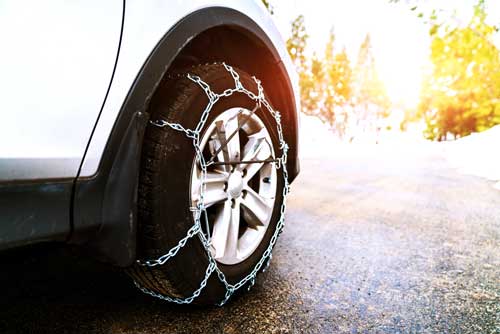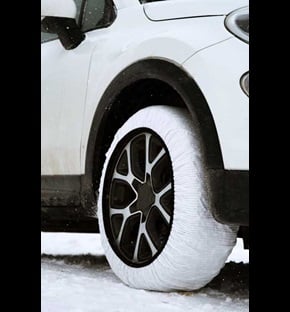
If you don't want the expense of winter tyres, but are looking for more grip when snow strikes, then snow chains and snow socks can be a decent alternative option.
On this page, we’ll explain the differences between the two and break down the scenarios where one might be better than the other.
What are snow chains and snow socks?
Snow chains are devices that fit to your vehicle’s tyres and provide increased grip and traction in snowy and icy conditions, while Snow socks are textile liners that wrap over the wheel and tyre to give improved grip.
Snow chains explained
Before using snow chains, there are a few key things you need to bear in mind:
- You can only use chains where snow or ice protects the road surface from damage.
- Tyres with chains on are wider so may contact bodywork, suspension or brake parts.
- Chains can affect the operation of electronic wheel sensors.
- Chains can be tricky to fit and remove
It's good practice to get used to fitting snow chains before you need to use them in snow or ice, consider getting someone with experience to help you out with the fitting.
When should I use snow chains?
Snow chains aren’t commonly needed in the UK compared to other European countries, owing to milder winter conditions. However, there are certain situations where it could be beneficial to use them, such as:
- When there’s severe snowfall or ice
- When you’re travelling to European countries that require you to have them
- If you’re travelling to an area that’s expecting severe snow
You should also check if your specific vehicle is able to use snow chains before attempting to fit them, otherwise you could cause expensive damage. Your handbook will make it clear if you can use snow chains.
You can only use chains where there’s enough snow or ice to protect the road.
- With this country’s policy of gritting and clearing major roads you’ll probably have to fit and remove chains several times during a journey.
- Choose a safe place and consider wearing a reflective jacket.
How do I put on snow chains?
Here’s a step-by-step guide for how to attach snow chains to your car.
1. Position the Chains: Hang the chains over the tyre and make sure the smooth side of any fasteners is facing the tyre – this should prevent any damage from occurring. Ensure the chains are centred on the tyre, with equal length on both sides.
2. Connect the Chains:
For Ladder Chains: Firstly, connect the inner side of the chain (the one closest to the vehicle). Then hook the ends together behind the tyre.
For Diamond or Cable Chains: This usually involves connecting an inner cable or chain first, but you should follow instructions for the specific type of chain that you have.
3. Drape and Adjust: The rest of the chain needs to be pulled over the tyre and connected to the outer side. Then you need to make sure the chains are evenly distributed and fit closely against the tyre.
4. Drive Forward Slightly: Move the vehicle forward by around a few feet until you have access to the part of the tyre that was touching the ground originally. This helps in adjusting the chains to ensure they are properly centred and tight.
5. Re-tighten: After inching the vehicle forward slightly, re-check and tighten the chains if necessary. Look out for the tightening mechanism or additional hooks – you can use these to ensure the chain fits properly.
6. Check for Security: Check that the chains are tight and evenly spread around the tyre, and that all connections are fit properly. You shouldn’t be able to move the chains at all if you’ve done it correctly.
How to drive with snow chains on
Your handbook and the instructions for the chains may give specific advice. Follow our tips below if you’re unable to find these:
- Traction control/anti-skid should normally be turned off
- Take it slowly (less than 20mph) and gently, slow down for bends and avoid harsh acceleration and braking
- Pull away slowly – if you spin the wheels you could damage your suspension or steering if a chain catches on a hidden tree stump or rock
- Stop and take the chains off straightaway if they’re damaged or broken
- Check for worn or broken links and connectors when you take the chains off
- Your chains will last longer if you clean and dry them before putting them away
Are snow chains legal in the UK?
Yes, snow chains are legal in the UK, but only when used in specific situations. They can only be used on snow – so if you’re driving on a clear or gritted road with snow chains, you could be causing damage to the road and committing an offence. If you know you’re going to travel on normal roads before getting to snowy ones, you’ll have to set off without chains and apply them later on.
Snow socks explained

Snow socks can be a less bulky, easier to fit alternative to snow chains, and are completely legal anywhere in the UK. They can come in handy if you’re not sure you’ll be driving in snowy or icy conditions and you at least want to equip your car with something just in case.
If your vehicle can’t use snow chains for any reason (such as being incompatible), then socks can be a decent alternative.
As with chains, you’ll have to take snow socks off when you get to a cleared road surface – the tyre won’t meet minimum tread requirements and the socks will wear out very quickly.
When should I use snow socks?
It might be more beneficial to use snow socks instead of snow chains in the following situations:
- If your main worry’s the beginning and end of a journey where local, un-gritted or little-used roads become icy
Bear in mind that socks aren’t as effective as chains and they’re not considered an 'approved' alternative to chains in countries where signs show that chains must be used
How do I put on snow socks?
Follow the steps below when putting on snow socks:
- Make sure to park on a flat surface and apply the handbrake
- Start by placing the elasticated band behind the top of the tyre
- Carefully drive forward or backwards by a few feet, until the part of the tyre that was touching the ground before is accessible
- Finish off putting the elasticated band behind the remainder of the tyre
- Drive for about 50 metres and then stop again to check if the snow sock has centred itself
How to drive with snow socks on
Follow our tips below when driving with snow socks on:
- Turn off your vehicle's traction control and try not to stray over 20 mph
- Do not spin your tyres
- Brake gently and keep below 20 mph
- Stop and remove your snow socks before driving on normal road surfaces if possible
Last updated: 7th November 2024
